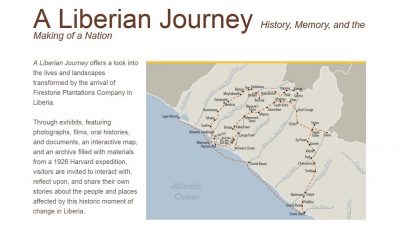Project Showcase: A Liberian Journey
08 June 2016 – editors

Screenshot credit: A Liberian Journey
On Monday, March 21, 2016 President Ellen Johnson Sirleaf of Liberia officially launched A Liberian Journey: History, Memory, and the Making of a Nation, a new digital public history project that is the product of a multi-year, multi-institutional collaboration. This effort marks the beginning of a recollection of Liberia’s lost history and represents a very important step in reawakening the Liberian national consciousness.
A Liberian Journey was developed in partnership with the Liberian Center for National Documents and Records Agency (CNDRA), the Indiana University Liberian Collections, the University of Wisconsin-Madison, and the Roy Rosenzweig Center for History and New Media, with support from the National Science Foundation. To ensure that Liberians can access A Liberian Journey, especially in areas with limited internet connectivity, the site is designed for use with mobile devices in the Omeka platform.
The goal of the project is to inform, raise questions, and invite stories about a transformational moment in Liberia’s past by making available for the first time in one place historical sources related to a 1926 Harvard scientific expedition to Liberia. That year Firestone Tire & Rubber Company secured a ninety-nine year lease for nearly one million acres of land from the Liberian government to establish one of the world’s largest rubber plantations. To help the company understand the conditions and challenges it would face in the country, Firestone sponsored a team of Harvard University scientists and physicians to conduct a four-month-long biological and medical survey. Loring Whitman, a Harvard medical student, served as the expedition’s official photographer, and his work includes the earliest known surviving motion picture footage of Liberia.
The website features an exhibit on Chief Suah Koko, a noted female leader in Liberia’s history; as well as digital collections containing nearly 600 photographs, more than two hours of motion picture footage, oral histories, and documents linked to an interactive map. The moving images and still photographs included in the site are products of American scientists and represent an early twentieth-century colonial world view. From the beginning of this digital project, it was important for the collections and digital media teams in the United States to collaborate closely with the content teams to work through the pitfalls and challenges of representing the colonial gaze embedded in the photographs and film. The team discussed how to describe these historical artifacts, how to introduce themes across the collections through tagging, and how to represent place names referred to in the expedition records and connect them to their current locations without reproducing the cultural contexts embedded in their creation. At the same time, the footage and photographs offer a valuable historical record of the peoples, cultural traditions, and landscapes of Liberia at a time of rapid economic, cultural, and environmental change.
Through this site, the project team offers these historical sources for reinterpretation and contextualization and seeks multiple perspectives on the past by inviting Liberians to participate as content creators and historians of their own lives.



